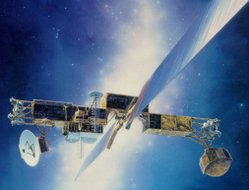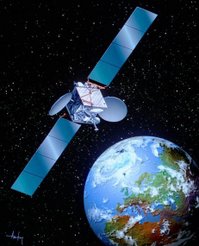Communications satellite

A communications satellite (sometimes abbreviated to comsat) is an artificial satellite stationed in space for the purposes of telecommunications. Modern communications satellites use geosynchronous orbits, Molniya orbits or low Earth orbits.
For fixed services, communications satellites provide a technology complementary to that of fiber optic submarine communication cables. For mobile applications, such as communications to ships and planes, for which application of other technologies, such as cable, are impractical or impossible.
History
Early missions
The first satellite to relay communications was Project SCORE in 1958, which used a tape recorder to store and forward voice messages. It was used to send a Christmas greeting to the world from President Eisenhower. NASA launched an Echo satellite in 1960. This 100-foot aluminized Mylar balloon served as a passive reflector for radio communications. Courier 1B, (built by Philco) also was launched in 1960, was the world’s first active repeater satellite.
Telstar was the first active, direct relay communications satellite. Belonging to AT&T as part of a multi-national agreement between AT&T, Bell Telephone Laboratories, NASA, the British General Post Office, and the French National PTT (Post Office) to develop satellite communication, it was launched by NASA from Cape Canaveral on July 10, 1962, the first privately sponsored space launch. Telstar was placed in an elliptical orbit (completed once every 2 hours and 37 minutes), rotating at a 45° angle above the equator.
An immediate antecedent of the geostationary satellites was Hughes’ Syncom 2, launched on July 26, 1963.
Syncom 2 revolved around the earth once per day at constant speed, but because it still had north-south motion special equipment was needed to track it.
Geostationary orbits
A satellite in a geostationary orbit appears to be in a fixed position to an earth-based observer. A geostationary satellite revolves around the earth at a constant speed once per day over the equator.
The geostationary orbit is useful for communications applications because ground based antennae, which must be directed toward the satellite, can operate effectively without the need for expensive equipment to track the satellite’s motion. Especially for applications that require a large number of ground antennae (such as direct TV distribution), the savings in ground equipment can more than justify the extra cost and onboard complexity of lifting a satellite into the relatively high geostationary orbit.
The concept of the geostationary communications satellite was first proposed by Arthur C. Clarke, building on work by Konstantin Tsiolkovsky and on the 1929 work by Herman Potočnik (writing as Herman Noordung) Das Problem der Befahrung des Weltraums - der Raketen-motor. In October 1945 Clarke published an article titled “[Extra-terrestrial Relays]” in the British magazine Wireless World. The article described the fundamentals behind the deployment of artificial satellites in geostationary orbits for the purpose of relaying radio signals. Thus Arthur C. Clarke is often quoted as being the inventor of the communications satellite.
The first geostationary communications satellite was Anik 1, a Canadian satellite launched in 1972. The United States launched their own geostationary communication satellites afterward, with Western Union launching their Westar 1 satellite in 1974, and RCA Americom (later GE Americom, now SES Americom) launching Satcom 1 in 1975.
It was Satcom 1 that was instrumental in helping early cable TV channels such as WTBS (now TBS Superstation), HBO, CBN (now ABC Family), and The Weather Channel become successful, because these channels distributed their programming to all of the local cable TV headends using the satellite. Additionally, it was the first satellite used by broadcast TV networks in the United States, like ABC, NBC, and CBS, to distribute their programming to all of their local affiliate stations. The reason that Satcom 1 was so widely used is that it had twice the communications capacity of Westar 1 (24 transponders as opposed to Westar 1’s 12), which resulted in lower transponder usage costs.
By 2000 Hughes Space and Communications (now Boeing Satellite Systems) had built nearly 40 percent of the satellites in service worldwide. Other major satellite manufacturers include Space Systems/Loral, Lockheed Martin (owns former RCA Astro Electronics/GE Astro Space business), Alcatel Space and EADS Astrium.
Low-Earth-orbiting satellites
A low Earth orbit typically is a circular orbit about 150 kilometres above the earth’s surface and, correspondingly, a period (time to revolve around the earth) of about 90 minutes. Because of their low altitude, these satellites are only visible from within a radius of roughly 1000 kilometres from the sub-satellite point. In addition, satellites in low earth orbit change their position relative to the ground position quickly. So even for local applications, a large number of satellites are needed if the mission requires uninterrupted connectivity.
Low earth orbiting satellites are less expensive to position in space than geostationary satellites and, because of their closer proximity to the ground, require lower signal strength. So there is a trade off between the number of satellites and their cost. In addition, there are important differences in the onboard and ground equipment needed to support the two types of missions.
A group of satellites working in concert thus is known as a satellite constellation. Two such constellations which were intended for provision for hand held telephony, primarily to remote areas, were the Iridium and Globalstar. The Iridium system has 66 satellites. Another LEO satellite constellation, with backing from Microsoft entrepreneur Paul Allen, was to have as many as 720 satellites.
It is also possible to offer discontinuous coverage using a low Earth orbit satellite capable of storing data received while passing over one part of Earth and transmitting it later while passing over another part. This will be the case with the CASCADE system of Canada’s CASSIOPE communications satellite.
Molniya satellites
As mentioned, geostationary satellites are constrained to operate above the equator. As a consequence, they are not always suitable for providing services at high latitudes: for at high latitudes a geostationary satellite may appear low on (or even below) the horizon, affecting connectivity and causing multipathing (interference caused by signals reflecting off the ground into the ground antenna). The first satellite of Molniya series was launched 04.23.1965 and was used for experimental transmission of TV signal from Moscow up-link station to down-link stations, located in Russian Far East, in Khabarovsk and Vladivostok.In 1967 Soviet engineers created an unique system of national TV network called Orbita that was based on Molniya satellites.
Molniya orbits can be an appealing alternative in such cases. The Molniya orbit is highly inclined, guaranteeing good elevation over selected positions during the northern portion of the orbit. (Elevation is the extent of the satellite’s position above the horizon. Thus a satellite at the horizon has zero elevation and a satellite directly overhead has elevation of 90 degrees).
Furthermore, the Molniya orbit is so designed that the satellite spends the great majority of its time over the far northern latitudes, during which its ground footprint moves only slightly. Its period is one half day, so that the satellite is available for operation over the targetted region for eight hours every second revolution. In this way a constellation of three Molniya satellites (plus in-orbit spares) can provide uninterrupted coverage.
Molniya satellites are typically used for telephony and TV services over Russia. Another application is to use them for mobile radio systems (even at lower latitudes) since cars travelling through urban areas need access to satellites at high elevation in order to secure good connectivity, e.g. in the presence of tall buildings.
Applications
Telephony
The first and still, arguably, most important application for communication satellites is in international telephony. Fixed-point telephones relay calls to an earth station, where they are then transmitted to a geostationary satellite. An analogous path is then followed on the downlink. In contrast, mobile telephones (to and from ships and airplanes) must be directly connected to equipment to uplink the signal to the satellite, as well as being able to ensure satellite pointing in the presence of disturbances, such as waves onboard a ship.
Hand held telephony (cellular phones) used in urban areas do not make use of satellite communications. Instead they have access to a ground based constellation of receiving and retransmitting stations.
Television and Radio
A direct broadcast satellite is a communications satellite that transmits to small DBS satellite dishes. Direct broadcast satellites generally operate in the upper portion of the Ku band. Other frequency bands include the original C band, Ku band, and eventually Ka band. See broadcast satellites for further information.
Initially available for broadcast to stationary TV receivers, by 2004 popular mobile direct broadcast applications made their appearance with that arrival of two satellite radio systems in the United States: Sirius and XM Satellite Radio Holdings.
Amateur radio
Amateur radio operators have access to the OSCAR satellites that have been designed specifically to carry amateur radio traffic. Most such satellites operate as spaceborne repeaters, and are generally accessed by amateurs equipped with UHF or VHF radio equipment and highly directional antennas such as Yagis or dish antennas. Due to the limitations of ground-based amateur equipment, most amateur satellites are launched into fairly low Earth orbits, and are designed to deal with only a limited number of brief contacts at any given time. Some satellites also provide data-forwarding services using the AX.25 or similar protocols.
See also
- Data Transmission Network
- DVB
- DigiCipher 2
- free-space optical communications
- ICO Global Communications
- Intelsat
- Iridium
- list of communications satellite firsts
- List of communication satellite companies
- Military Strategic and Tactical Relay satellite (MILSTAR)
- reconnaissance satellite
- Satellite dish
- Satmodem
- satellite television
- satellite radio
- space communications
- Syncom
- Teledesic
- Telstar
- X*Press X*Change
External links
- The future of communication satellite business
- Communications satellites short history by David J. Whalen
- Beyond The Ionosphere: Fifty Years of Satellite Communication (NASA SP-4217, 1997) – an entire book online—scroll down for “contents” link.
- NASA experimental communications satellites
- Syncom 2 satellite description
- VSAT antennas
- Communications trough satellite
- Lloyd’s Satellite Constellations
- Satellite Radio
- Satcom Online – A Resource for Satcom Engineers

